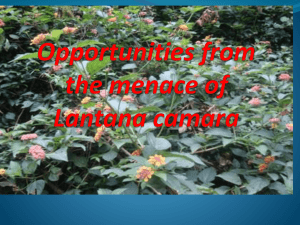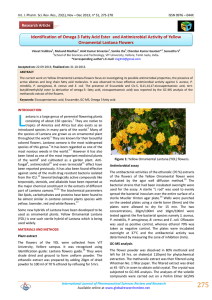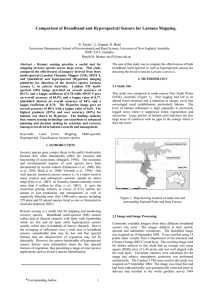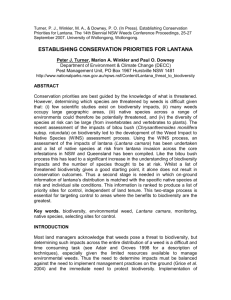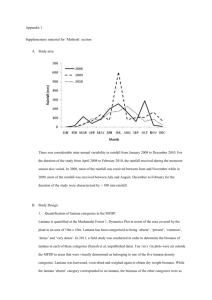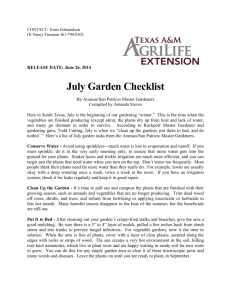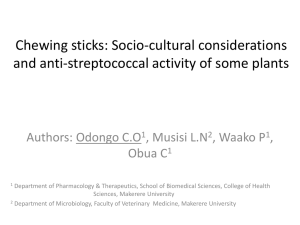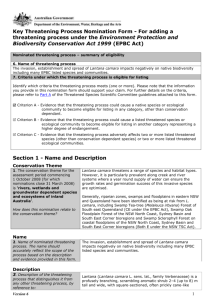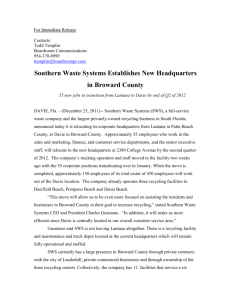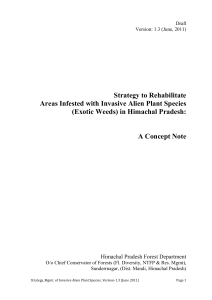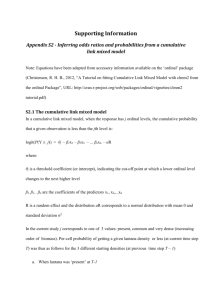Proclaimed Plant Policy
advertisement
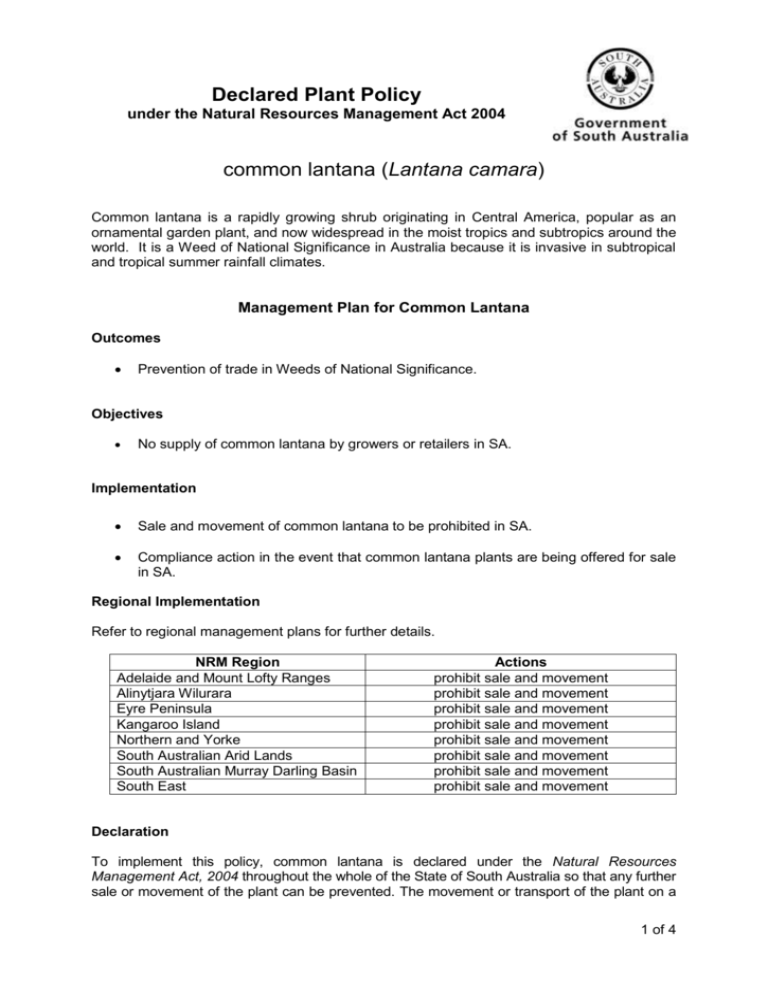
Declared Plant Policy under the Natural Resources Management Act 2004 common lantana (Lantana camara) Common lantana is a rapidly growing shrub originating in Central America, popular as an ornamental garden plant, and now widespread in the moist tropics and subtropics around the world. It is a Weed of National Significance in Australia because it is invasive in subtropical and tropical summer rainfall climates. Management Plan for Common Lantana Outcomes Prevention of trade in Weeds of National Significance. Objectives No supply of common lantana by growers or retailers in SA. Implementation Sale and movement of common lantana to be prohibited in SA. Compliance action in the event that common lantana plants are being offered for sale in SA. Regional Implementation Refer to regional management plans for further details. NRM Region Adelaide and Mount Lofty Ranges Alinytjara Wilurara Eyre Peninsula Kangaroo Island Northern and Yorke South Australian Arid Lands South Australian Murray Darling Basin South East Actions prohibit sale and movement prohibit sale and movement prohibit sale and movement prohibit sale and movement prohibit sale and movement prohibit sale and movement prohibit sale and movement prohibit sale and movement Declaration To implement this policy, common lantana is declared under the Natural Resources Management Act, 2004 throughout the whole of the State of South Australia so that any further sale or movement of the plant can be prevented. The movement or transport of the plant on a 1 of 4 common lantana policy public road by itself or as a contaminant, its entry to South Australia, or sale by itself or as a contaminant are prohibited. Common lantana is declared in category 3 under the Act for the purpose of setting maximum penalties and for other purposes. Any permit to allow its movement or sale can only be issued by the regional NRM Board pursuant to section 188. The following sections of the Act apply to common lantana throughout each of the the NRM regions noted below: EP KI NY SAAL SAMDB SE 175(1) Prohibiting entry to area 175(2) Prohibiting movement on public roads 177(1) Prohibiting sale of the plant 177(2) Prohibiting sale of contaminated goods 180 Requiring notification of infestations 182(1) Landowners to destroy the plant on their properties 182(2) Landowners to control the plant on their properties 185 Recovery of control costs on adjoining road reserves AW Sections of Act AMLR Region X X X X X X X X X X X X X X X X X X X X X X X X X X X X X X X X Review Success of the program will be measured by its effectiveness in stopping trade in common lantana within SA or its supply from SA to other jurisdictions. This policy is to be reviewed by 2020, or in the event of a change in the status of common lantana as a Weed of National Significance. Weed Risk Invasiveness Common lantana produces abundant seed in berries, which may be dispersed by many species of bird. Where invasion occurs it is linked with disturbance, including bare ground, open canopies and unimproved pastures. However, there are no records of it spreading by seed in SA. Impacts No impact of lantana on native vegetation has been recorded in SA. In States where it can establish it has become a major invader of bushland, dominating understoreys, altering succession processes and reducing diversity. Potential distribution Common lantana has not established in native vegetation or grazing land in SA despite having been cultivated here since the late 19th century. Some gullies in the high-rainfall parts of the Mount Lofty Ranges may provide suitable habitat for it. 2 of 4 common lantana policy Feasibility of Containment Control costs Removal of lantana is labour-intensive in regions such as Queensland and New South Wales where it becomes established. Persistence Common lantana is a hardy shrub that persists in old gardens, but does not persist outside cultivation in SA. Current distribution Common lantana is not known to be naturalised in South Australia. State Level Risk Assessment Assessment using the Biosecurity SA Weed Risk Management System gave the following comparative weed risk and feasibility of containment scores by land use: Land use Native vegetation Weed Risk negligible 4 Feasibility of control very high 2 Response at State Level monitor Considerations Common lantana is one of the Weeds of National Significance, which are subject to a uniform prohibition on sale in all States and Territories as agreed by the Natural Resource Management Ministerial Council. Item 2.2.2 of the national strategy on lantana calls for the sale and distribution of all nonsterile forms of Lantana camara to be phased out nationally. In compliance this strategy, sale of the plant and its seed is prohibited in South Australia as in other jurisdictions. Synonymy Lantana camara L. , Sp. Pl. 2: 627 (1753) Taxonomic synonyms: Camara vulgaris Benth., Bot. Voy. Sulphur 154 (1846) Lantana aculeata L., Sp. Pl. 2: 627 (1753) Lantana crocea Jacq., Pl. Hort. Schoenbr. 4: 37 (1804) Lantana flava Medik., Act. Acad. Theod. Palat. iii. Phys 3: 225 (1775) Lantana hybrida Hort. ex Neub., Deutsch. Gart. Mag. 10: 98 (1857) Lantana mista L.., Syst. Nat. 2: 417 (1767) Lantana nivea Vent., Jard. Malmaison 1,2: 8 (1803) Lantana sanguinea Medik., Act. Acad. Theod. Palat. iii. Phys 3: 227 (1775) Lantana splendens Medik., Act. Acad. Theod. Palat. iii. Phys 3: 226 (1775) Other common names include large-leaf lantana and kamara lantana. 3 of 4 common lantana policy References Agriculture & Resource Management Council of Australia & New Zealand Australia & New Zealand Environment & Conservation Council and Forestry Ministers (2001) 'Weeds of National Significance Lantana (Lantana camara) Strategic Plan.' (National Weeds Strategy Executive Committee: Launceston) Munir, A.A. (1996) A taxonomic review of Lantana camara L. and L. montevidensis (Spreng.)Briq. (Verbenaceae) in Australia. J. Adelaide Bot. Gard. 17: 1-28. Sanders, R.W. (2006) Taxonomy of Lantana Sect. Lantana (Verbenaceae): I. Correct application of Lantana camara and associated names. Sida 22: 381-421. Hon Ian Hunter MP Minister for Sustainability, Environment and Conservation Date: 28 July 2014 4 of 4
